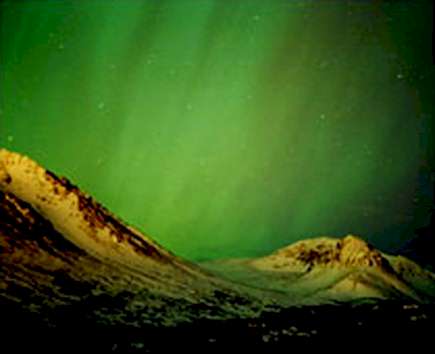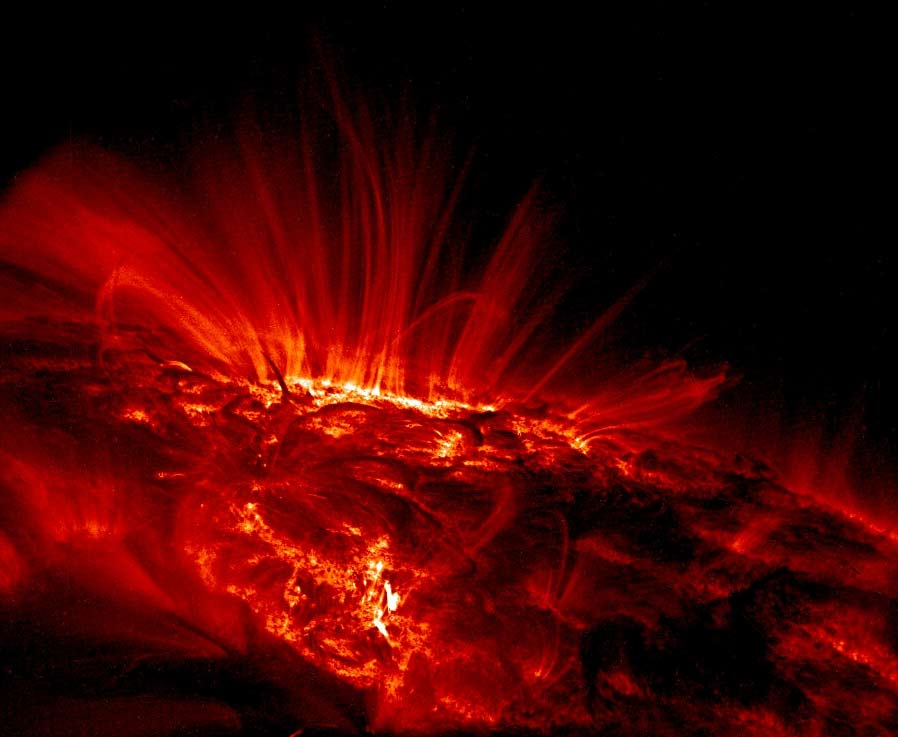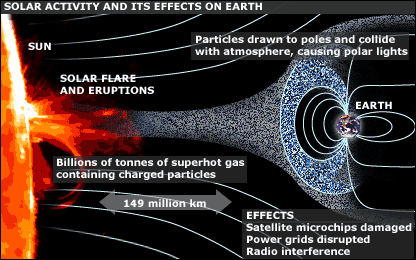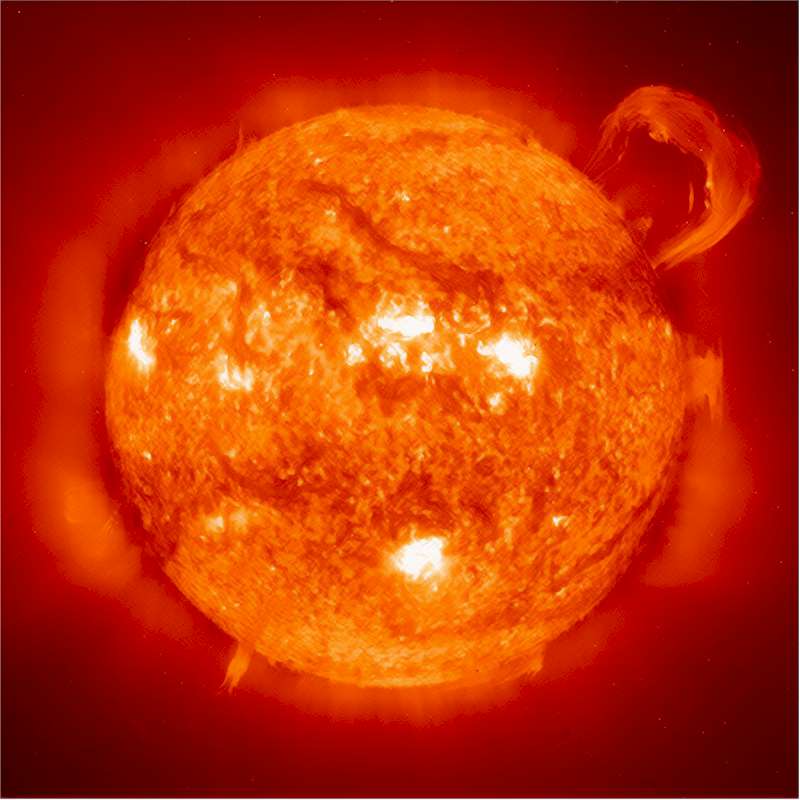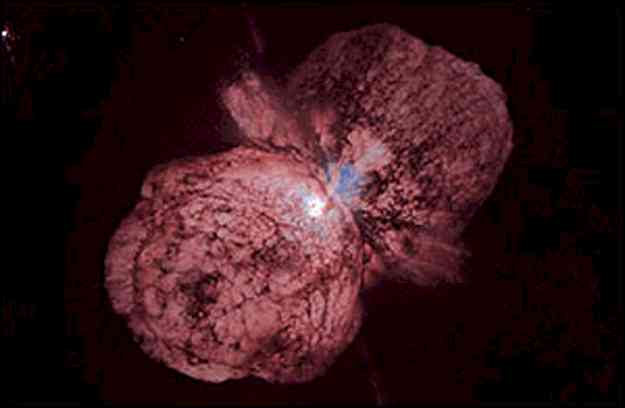Earth's Problems Measured on Galactic Scale
Earth No Passive Victim of Solar StormsI have no doubt that we will be successful in harnessing the sun's energy... - Sir George Porter
Washington - The earth reacts so strongly to the solar wind that it helps create space storms that disrupt electricity grids and satellite and radio communications, surprised NASA scientists have said. The earth's outer atmosphere works as a heat shield to deflect and absorb some of the damaging energy, but in the process creates a billion-degree cloud of electrified gas that sets up loops of multimillion amp electric current. Scientists at the US space agency said they were somewhat surprised by the data from NASA's Imager for Magnetopause to Aurora Global Exploration (IMAGE) spacecraft, which has been watching what happens when solar storms hit the planet since it was launched in 2000. "We knew this was going on but we didn't really know the whole range of dynamical behaviour or time scales. We were really surprised how fast it all happens," Janet Kozyra, senior research scientist at the University of Michigan, said in an interview. The solar wind blows constantly at an average speed of 250 miles per second (400 km per second). It has long been associated with geomagnetic storms on earth - it is the cause of the aurora borealis (also called northern lights). IMAGE has allowed scientists to see the other side of the storms, from space. The result is dramatic. IMAGE data, translated into visuals by computer, shows the superheated gas called plasma streaming from the sun and hitting the earth's outer atmosphere. Most is deflected but some starts a reaction with the atmosphere itself. "It shows bursts of hydrogen and oxygen coming out of earth's atmosphere," Stephen Fuselier, manager of the Space Physics Laboratory at Lockheed-Martin Advanced Technology Center in Palo Alto, California, told reporters. "The timing is most important - there is a direct input from the solar wind. The earth responds immediately by ejecting a part of the atmosphere." It is a very small part, Fuselier stresses - a stream of charged oxygen atoms. Each storm accounts for about 100 tons of oxygen expelled into space. "That is about the air volume in the Louisiana Superdome," he said. "That sounds like a lot by human standards but in fact earth's atmosphere is much, much larger than that." He said even billions of years of storms would not measurably deplete the atmosphere. The moment it hits space, this oxygen becomes super-charged in bursts that can also been "seen" by IMAGE. Some of it loops backs into the atmosphere but much gets caught up in the solar wind and is carried away. "It has gained 100,000 times the energy it had when it left the atmosphere so it is very pumped up," Fuselier said. "When it plunges into the atmosphere, these strong currents are generated. They transform the mid-latitudes from their usual calm state into kind of a maelstrom that has direct effects on our daily lives." Such storms have knocked entire power grids offline and can interrupt radio broadcasts and satellite signals - including global positioning satellite or GPS technology relied upon by hikers, marine traffic and soldiers in the field. "This is "how space storms reach down into the Earth and touch our daily lives," John Foster of the Massachusetts Institute of Technology Haystack Observatory said. Scientists say understanding how the earth's own atmosphere is involved will help them find better ways to forecast these storms and perhaps even find ways to minimise their effects. Source: CNN 9 May 2002 Reuters photo credit Joe Slagle See also:
Where the Wind BlowsThis is the most stunning photo of the sun I've ever seen...
Sunspot Loops in Ultraviolet It was a quiet day on the sun. The above image shows, however, that even during off days the sun's surface is a busy place. Shown in ultraviolet light, the relatively cool dark regions have temperatures of thousands of degrees Celsius. Large sunspot group AR 9169 is visible as the bright area near the horizon. The bright glowing gas flowing around the sunspots has a temperature of over one million degrees Celsius. The reason for the high temperatures is unknown but thought to be related to the rapidly changing magnetic field loops that channel solar plasma. Sunspot group AR 9169 moved across the Sun during 2000 September and decayed in a few weeks. Source: antwrp.gsfc.nasa.gov
Sun "Sheds Its Skin Like a Snake"
by Dr David Whitehouse Astronomers have discovered a key fact required to understand the sun's 11-year cycle of activity. Sunspots and flares on the sun's surface follow the cycle, but expelled gas clouds do not. It seems that these ejections trail the sunspot peak - they peaked in 2002, two years after sunspots. The expelled gas takes away the sun's old magnetic skin allowing a new one to emerge to start a new cycle. The sun's 11-year cycle of activity - as recognised by the coming and going of sunspots - has been known since 1843, when Heinrich Schwabe, a German astronomer, noticed the pattern. Years later the activity was recognised as being of magnetic origin by George Ellery Hale, the American astronomer, who, in 1908, saw that sunspots were intensely magnetic. Since then many theories have been put forward to explain the solar rhythm. The accepted theory is that the sunspot cycle is a consequence of rotation and convection inside the sun. The fact that the sun's outer layers are bubbling, and that the sun rotates faster at the equator than the poles, and faster on the inside than on the surface, results in a solar dynamo that, over 11 years, becomes increasingly wound up. So at some stage during the magnetic cycle the sun has to somehow shed its old, contorted magnetic skin, and allow a newer, less troubled one, to emerge.
Source: strak.com The Soho (Solar Heliospheric Observatory) satellite may have obtained evidence about how the sun does it. Eight years of observing gas eruptions - Coronal Mass Ejections (CME's) - show that they are removing the sun's old magnetic field bit by bit, first from one pole and the equator, and then the other pole. "The sun is like a snake that sheds its skin," says Nat Gopalswamy of NASA's Goddard Space Flight Centre, author of a report in the Astrophysical Journal. "In this case, it's a magnetic skin. The process is long, drawn-out and it's pretty violent. More than a thousand coronal mass ejections, each carrying billions of tons of gas from the polar regions, are needed to clear the old magnetism away. But when it's all over the sun's magnetic stripes are running in the opposite direction." "This analysis of nearly eight years of CME data is a big step forward in making sense of space weather," says Joseph Gurman, NASA Project Scientist for Soho. "By identifying the solar origin of these events with CME's of different speeds and appearances, and at different latitudes, it improves our capability to predict space weather that can affect the earth, at different phases of the solar activity cycle." Dr David Whitehouse is the science editor for the BBC News Online Source: news.bbc.co.uk 24 November 2003
Cosmic Catastrophe "A Certainty"
Eta Carinae will explode soon but luckily it is not pointing our way by Dr David Whitehouse Sooner or later, a catastrophe from space will wipe out almost all life on earth. The few who might survive, struggling forlornly on a wrecked planet, might wish they had died. According to Dr Arnon Dar, of the Technion Space Research Institute, Israel, a particular type of exploding star going off anywhere in our region of the universe would devastate our planet. Using the latest statistics and calculations, Dar argues that a supermassive star collapsing at the end of its lifetime would form a black hole and send out a beam of destructive radiation and particles that would sterilise any planet in its path. The odds are that any planet in our galaxy would be affected about once every 100 million years. "It is a certainty; the timescales are comparable to mass extinctions seen in earth's geological record," Dr Dar said. Supermassive stars, those with a mass substantially greater than our sun, are scattered throughout the galaxy. It is thought that when they collapse at the end of their lives, they eject an intense beam of radiation, called gamma-rays, into space. So powerful are these gamma-rays, and the energetic sub-atomic particles that follow in their wake, that they could have a major influence on life in our galaxy. "If such a beam were to strike earth, the effects would be totally devastating, unlike anything we could imagine," Dr Dar said. On the side of Earth facing the explosion, searing shock waves will begin to rip through the atmosphere igniting infernos when they reach the ground. Within moments of the arrival of the radiation from deep space, the atmospheric temperature will begin rising rapidly, wreaking havoc with global weather systems. All organic material on the surface of earth will start to burn. Survivors will cower in caves and buildings. But the worst is yet to come. The initial gamma-ray burst will last a fraction of a second. Almost immediately afterwards will come the cosmic rays, which will drench our planet for days. There will be no hiding place. Cosmic rays are highly energetic particles travelling through space at almost the speed of light. They will slam into the atmosphere, depositing vast amounts of energy and creating swarms of destructive "daughter" particles. These particles, called muons, will penetrate hundreds of metres into rocks so that few caves will offer protection and even deep-sea creatures will be affected by lethal doses of radiation. The earth's ecosystem will be destroyed. "The few who might survive will wish they had died," said Dr Dar. "They will struggle, forlornly, on a wrecked planet." Dr Dar points out that many of the great extinctions that regularly punctuate the earth's history are consistent with being caused by a devastating influx of radiation from space. "Direct proof that it happened this way is lacking at present," he said, "but many people are looking for it." There is some good news! Because the gamma-ray bursts from collapsing supermassive stars are shot across the cosmos in narrow beams, probably no more than a degree across, most of them will miss the earth. However, the latest statistics suggest once every 100 million years or so, we will be unlucky. Curiously, this is about the rate of global extinctions on earth. At the moment, astronomers do not know which star to watch. Stars, like the supermassive Eta Carinae, visible in the Southern Hemisphere, are likely to explode and send out a gamma-ray burst sometime in the next million years or so. But this particular star is not pointing in our direction. Undoubtedly, there is a star that is, but as yet astronomers have not found it. But even if they do, will we get any warning? "Not with our current understanding of science," said Dr Dar, "but then science progresses. Perhaps, one day we will be able to tell which stars are threatening." Dr David Whitehouse is the BBC News online science editor Source: news.bbc.co.uk Wednesday 8 May 2002 photo credit NASA
Supernova Poised to Go Off Near Earthby Eugenie Samuel A student at Harvard University has stumbled across the terrifying spectacle of a star in our galactic backyard that is on the brink of exploding in a supernova. It is so close that if it were to blow up before moving away from us, it could wipe out life on earth. Most supernovae occur when large stars run out of fuel and then collapse under their own weight. As atoms in the star are squeezed together, they rebound outwards, blowing off energy in a dazzling and dangerous display lasting several weeks. But this one is different. Called HR 8210, it is a humble white dwarf, a star that has run out of fuel and should be too small to produce a supernova. But it may not stay that way. First, it is not alone, but is orbiting a companion star in a typical binary system. And it is 1.15 times the mass of our sun, which for a white dwarf is a whopper. The system was first logged in 1993 but little attention was paid to it. Then when Harvard student Karin Sandstrom investigated HR 8210 for a college paper this year, she discovered that it is only just shy of the Chandrasekar limit - the mass at which it would be big enough to go supernova. That makes it the best and by far the closest supernova candidate discovered so far. The crunch will come when HR 8210's companion begins to run out of fuel. As it expands to form a red giant star, its outer layers will be dumped onto HR 8210, pushing it over the Chandrasekar limit. "Our initial idea was that this might happen very soon," says Sandstrom's supervisor Dave Latham. But do not panic yet. "Very soon" could mean hundreds of millions of years in the future. And that is just as well, because we are only 150 light years away from HR 8210 at present - well short of the 160 to 200 light years thought to be the minimum safe distance from a supernova. If it did let fly, the high-energy electromagnetic radiation and cosmic rays it released would destroy Earth's ozone layer within minutes, giving life little chance of survival. This would not be the first time a supernova has changed the course of life on Earth. In 2001, Jesus Maiz-Apellaniz and colleagues from the Space Telescope Science Institute in Baltimore, Maryland, found a "smoking gun" supernova remnant, in the group of stars known as the Scorpius- Centaurus association. The timing of the supernova corresponds to an otherwise mysterious deposit of heavy isotopes in deep Earth cores and to a mass marine extinction two million years ago. At the time, Scorpius-Centaurus was around twice as far away from Earth as HR 8210 is now. Fortunately, it will take time for HR 8210 to accumulate the mass it needs. Preliminary calculations by Rosanne di Stefano at the Harvard-Smithsonian Center suggest this may take hundreds of millions of years. By that time it will be much further away, she says, though she still needs to confirm exactly how far. "I want to be sure I'm right." But will similar stars threaten us before then? "The fact that there's such a system so close to us suggests maybe these objects are not so rare," says Latham. Source: newscientist.com from the print edition 23 May 2002
Three Cosmic Enigmas, One Answerby Zeeya Merali Dark energy and dark matter, two of the greatest mysteries confronting physicists, may be two sides of the same coin. A new and as yet undiscovered kind of star could explain both phenomena and, in turn, remove black holes from the lexicon of cosmology. The audacious idea comes from George Chapline, a physicist at Lawrence Livermore National Laboratory in California, and Nobel laureate Robert Laughlin of Stanford University and their colleagues. Last week at the 22nd Pacific Coast Gravity Meeting in Santa Barbara, California, Chapline suggested that the objects that till now have been thought of as black holes could in fact be dead stars that form as a result of an obscure quantum phenomenon. These stars could explain both dark energy and dark matter. This radical suggestion would get round some fundamental problems posed by the existence of black holes. One such problem arises from the idea that once matter crosses a black hole's event horizon – the point beyond which not even light can escape – it will be destroyed by the spacetime "singularity" at the centre of the black hole. Because information about the matter is lost forever, this conflicts with the laws of quantum mechanics, which state that information can never disappear from the universe. Another problem is that light from an object falling into a black hole is stretched so dramatically by the immense gravity there that observers outside will see time freeze: the object will appear to sit at the event horizon forever. This freezing of time also violates quantum mechanics. "People have been vaguely uncomfortable about these problems for a while, but they figured they'd get solved someday," says Chapline. "But that hasn't happened and I'm sure when historians look back, they'll wonder why people didn't question these contradictions." While looking for ways to avoid these physical paradoxes, Chapline and Laughlin found some answers in an unrelated phenomenon: the bizarre behaviour of superconducting crystals as they go through something called "quantum critical phase transition" (New Scientist, 28 January, p 40). During this transition, the spin of the electrons in the crystals is predicted to fluctuate wildly, but this prediction is not borne out by observation. Instead, the fluctuations appear to slow down, and even become still, as if time itself has slowed down. "That was when we had our epiphany," Chapline says. He and Laughlin realised that if a quantum critical phase transition happened on the surface of a star, it would slow down time and the surface would behave just like a black hole's event horizon. Quantum mechanics would not be violated because in this scenario time would never freeze entirely. "We start with effects actually seen in the lab, which I think gives it more credibility than black holes," says Chapline. With this idea in mind, they – along with Emil Mottola at the Los Alamos National Laboratory in New Mexico, Pawel Mazur of the University of South Carolina in Columbia and colleagues – analysed the collapse of massive stars in a way that did not allow any violation of quantum mechanics. Sure enough, in place of black holes their analysis predicts a phase transition that creates a thin quantum critical shell. The size of this shell is determined by the star's mass and, crucially, does not contain a space-time singularity. Instead, the shell contains a vacuum, just like the energy-containing vacuum of free space. As the star's mass collapses through the shell, it is converted to energy that contributes to the energy of the vacuum. The team's calculations show that the vacuum energy inside the shell has a powerful anti-gravity effect, just like the dark energy that appears to be causing the expansion of the universe to accelerate. Chapline has dubbed the objects produced this way "dark energy stars". Though this anti-gravity effect might be expected to blow the star's shell apart, calculations by Francisco Lobo of the University of Lisbon in Portugal have shown that stable dark energy stars can exist for a number of different models of vacuum energy. What's more, these stable stars would have shells that lie near the region where a black hole's event horizon would form (Classical Quantum Gravity, vol 23, p 1525). "Dark energy stars and black holes would have identical external geometries, so it will be very difficult to tell them apart," Lobo says. "All observations used as evidence for black holes – their gravitational pull on objects and the formation of accretion discs of matter around them – could also work as evidence for dark energy stars." That does not mean they are completely indistinguishable. While black holes supposedly swallow anything that gets past the event horizon, quantum critical shells are a two-way street, Chapline says. Matter crossing the shell decays, and the anti-gravity should spit some of the remnants back out again. Also, quark particles crossing the shell should decay by releasing positrons and gamma rays, which would pop out of the surface. This could explain the excess positrons that are seen at the centre of our galaxy, around the region that was hitherto thought to harbour a massive black hole. Conventional models cannot adequately explain these positrons, Chapline says. He and his colleagues have also calculated the energy spectrum of the released gamma rays. "It is very similar to the spectrum observed in gamma-ray bursts," says Chapline. The team also predicts that matter falling into a dark energy star will heat up the star, causing it to emit infrared radiation. "As telescopes improve over the next decade, we'll be able to search for this light," says Chapline. "This is a theory that should be proved one way or the other in 5 to 10 years." Black hole expert Marek Abramowicz at Gothenburg University in Sweden agrees that the idea of dark energy stars is worth pursuing. "We really don't have proof that black holes exist," he says. "This is a very interesting alternative." The most intriguing fallout from this idea has to do with the strength of the vacuum energy inside the dark energy star. This energy is related to the star's size, and for a star as big as our universe the calculated vacuum energy inside its shell matches the value of dark energy seen in the universe today. "It's like we are living inside a giant dark energy star," Chapline says. There is, of course, no explanation yet for how a universe-sized star could come into being. At the other end of the size scale, small versions of these stars could explain dark matter. "The big bang would have created zillions of tiny dark energy stars out of the vacuum," says Chapline, who worked on this idea with Mazur. "Our universe is pervaded by dark energy, with tiny dark energy stars peppered across it." These small dark energy stars would behave just like dark matter particles: their gravity would tug on the matter around them, but they would otherwise be invisible. Abramowicz says we know too little about dark energy and dark matter to judge Chapline and Laughlin's idea, but he is not dismissing it out of hand. "At the very least we can say the idea isn't impossible." Source: eurekalert.org from newscientist.com © Reed Business Information Limited New Scientist Magazine issue 11 March 2006. If reporting on this story, please mention New Scientist as the source. UK Contact - Claire Bowles, New Scientist Press Office, London: Tel: +44(0)20 7611 1210 or email claire.bowles@rbi.co.uk US Contact kyre.austin@reedbusiness.com
For articles on bacteria, centrioles, chairs, nebulae, asteroids, robots, memory, chirality, pain, fractals, DNA, geology, strange facts, extra dimensions, spare parts,
discoveries, ageing and more click the "Up" button below to take you to the Table of Contents for this Science section. |
 Animals
Animals Animation
Animation Art of Playing Cards
Art of Playing Cards Drugs
Drugs Education
Education Environment
Environment Flying
Flying History
History Humour
Humour Immigration
Immigration Info/Tech
Info/Tech Intellectual/Entertaining
Intellectual/Entertaining Lifestyles
Lifestyles Men
Men Money/Politics/Law
Money/Politics/Law New Jersey
New Jersey Odds and Oddities
Odds and Oddities Older & Under
Older & Under Photography
Photography Prisons
Prisons Relationships
Relationships Science
Science Social/Cultural
Social/Cultural Terrorism
Terrorism Wellington
Wellington Working
Working Zero Return Investment
Zero Return Investment